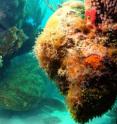Dry Tortugas show positive trends: Protected area slowly rebounding
A team of 38 research divers from the University of Miami (UM) Rosenstiel School of Marine and Atmospheric Science, NOAA Fisheries Service, the Florida Fish and Wildlife Conservation Commission, the National Park Service, REEF, and the University of North Carolina at Wilmington recently completed a successful 20-day biennial census to measure how the protected status of the Florida Keys National Marine Sanctuary's Tortugas Ecological Reserve and Dry Tortugas National Park's Research Natural Area are helping the regional ecosystem rebound from decades of overfishing and environmental changes. The unprecedented collaboration allowed the team to complete more than 1,700 scientific dives, which will now help to further establish a baseline for the state of reef fish stocks and coral reef habitats in Florida's dynamic marine ecosystem. According to Jerry Ault, Ph.D., professor of marine biology and fisheries at UM's Rosenstiel School and chief scientist on the cruise. "We are very encouraged to see that stocks have slowly begun to recuperate since the implementation of 'no-take' marine protected areas in the region. We noted particular improvements in the numbers of snapper, grouper, and coral recruits. We are currently crunching the data collected to see what adjustments may need to be made in order to help guide future management decisions to address the issues of biodiversity protection, restoration of ecological integrity, and fishery management which are critical to this area."
This year, the team documented changes in fish abundance and habitat quality in this region, which was hit by six major hurricanes since 2004. By statistically comparing this year's findings to previous survey information collected, scientists can determine what effects intense hurricane activity had on this marine environment.
The Dry Tortugas, a remote area about 70 miles to the west of Key West, Fla., is known for its extensive coral reefs, fish, sharks, lobsters and other marine life. In 2001, after an extensive designation process the Florida Keys National Marine Sanctuary implemented the Tortugas Ecological Reserve, consisting of 151 square nautical miles of protected marine habitat.
A complete report on the expedition is anticipated to be available in September 2008.
DRY TORTUGAS RESEARCH EXPEDITION
Preliminary Statistics
2008 Mission
- Total length of expedition = 20 days
- Number of research divers = 38 total
- Number of research dives or surveys = 1,710 – a new record for the team
- Types of dives = 1,245 RVC (reef fish visual census); 306 lobster; 80 coral-benthic - (plus another ≈ 250 on NPS Vessel Fort Jefferson during the same time period)
- Number of dives on which video was captured = 72
- Dives broken out by entity = UMiami 541; NOAA 515; FWRI 461; NPS 63; REEF 76.
- Average dives per day = 86
- Cumulative total bottom time = 1,109.4 hours (or 46.2 24-hour days) underwater
- Cubic feet of 36% Nitrox Gas = 2,691,740
- Cumulative depth of dives = 18.91 miles or 99,876 feet undersea (equivalent to 1.53 times the distance from the depths of the Mariana's Trench to the top of Mount Everest)
- Surveyed 336 primary sampling units (200 m x 200 m) classified grid cells
- Coral reef habitat surveyed in the Dry Tortugas region = 229,348 square meters (m2)
- Breakdown of area surveyed = Fish: 221,788 m2; Lobster 6,120 m2 ; Corals-benthic 1,440 m2
- Total domain actually visited = 0.07% of the total
- Statistical survey design achieved a coefficient of variation (CV ) of about 15% for population abundance estimates for about 280 species of fish.
Expedition Leaders
Dr. Jerald S. Ault, University of Miami RSMAS (Chief Scientist & Co-Principal Investigator)
Dr. G. Todd Kellison, NOAA Fisheries (Co-Principal Investigator)
Dave McClelland, NOAA Dive Safety Officer
Dr. Steven G. Smith, University of Miami, Mission Logistics
Doug Harper, NOAA Fisheries, Mission Information Management
Dr. Jiangang Luo, University of Miami, Mission Videography
Entities Involved
- NOAA Fisheries Service
- University of Miami/Rosenstiel School of Marine and Atmospheric Science
- Florida Fish and Wildlife Conservation Commission
- National Park Service
- National Undersea Laboratory - UNC Wilmington
- REEF (Reef Educational and Environmental Foundation)
Mission Dates
Leg 1: May 12-21
Leg 2: May 31-June 9
Overall Totals from 1999 – 2008
- Number of Missions: 6
- Total research dives: 7,488
- Days of operation in the six missions: 106 days
Source: University of Miami Rosenstiel School of Marine & Atmospheric Science
Other sources
- Dry Tortugas Show Positive Trends: Protected Area Slowly Reboundingfrom Science DailyFri, 27 Jun 2008, 2:21:37 UTC
- Study: Dry Tortugas has signs of recoveryfrom UPIWed, 25 Jun 2008, 20:42:06 UTC
- Dry Tortugas show positive trends: Protected area slowly reboundingfrom PhysorgMon, 23 Jun 2008, 15:21:31 UTC
